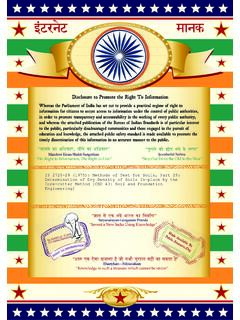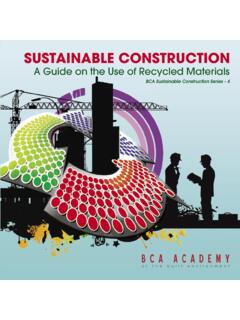Transcription of Guidelines for soil description - Food and Agriculture ...
1 Guidelines FOR. soil description . Universit t Halle-Wittenberg, Germany Guidelines FOR soil description . Universit t Kiel, Germany Leyte State University, The Philippines ISRIC World soil Information, The Netherlands Technische Universit t M nchen, Germany . FAO.. Guidelines for soil description Fourth edition FOOD AND Agriculture ORGANIZATION OF THE UNITED NATIONS. Rome, 2006. The designations employed and the presentation of material in this information product do not imply the expression of any opinion whatsoever on the part of the Food and Agriculture Organization of the United Nations concerning the legal or development status of any country, territory, city or area or of its authorities, or concerning the delimitation of its frontiers or boundaries.
2 ISBN 92-5-105521-1. All rights reserved. Reproduction and dissemination of material in this information product for educational or other non-commercial purposes are authorized without any prior written permission from the copyright holders provided the source is fully acknowledged. Reproduction of material in this information product for resale or other commercial purposes is prohibited without written permission of the copyright holders. Applications for such permission should be addressed to: Chief Publishing Management Service Information Division FAO. Viale delle Terme di Caracalla, 00100 Rome, Italy or by e-mail to: FAO 2006.
3 Iii Contents Acknowledgements ix List of acronyms x 1. Introduction 1. 2. General site information, registration and location 5. Profile number 5. soil profile description status 5. Date of description 5. Authors 5. Location 6. Elevation 6. Map sheet number and grid reference (coordinates) 7. 3. soil formation factors 9. Atmospheric climate and weather conditions 9. soil climate 9. Landform and topography (relief) 10. Major landform 10. Position 10. Slope form 12. Slope gradient and orientation 12. Land use and vegetation 13. Land use 13. Crops 13. Human influence 13. Vegetation 16.
4 Parent material 16. Age of the land surface 17. 4. soil description 21. Surface characteristics 21. Rock outcrops 21. Coarse surface fragments 21. Erosion 22. Surface sealing 23. Surface cracks 23. iv Horizon boundary 24. Depth 24. Distinctness and topography 25. Primary constituents 25. Texture of the fine earth fraction 25. Rock fragments and artefacts 29. Degree of decomposition and humification of peat 32. Aeromorphic organic layers on forest floors 32. soil colour (matrix) 33. Mottling 35. Colour of mottles 35. Abundance of mottles 35. Size of mottles 35. Contrast of mottles 36.
5 Boundary of mottles 36. soil redox potential and reducing conditions 36. Determination of redox potential by field method 36. Reducing conditions 37. Carbonates 38. Content 38. Forms 38. Gypsum 39. Content of gypsum 39. Forms of secondary gypsum 39. Readily soluble salts 40. Procedure 40. Field soil pH 41. soil odour 42. Andic characteristics and volcanic glasses 42. Procedure 42. Organic matter content 43. Organization of soil constituents 44. soil structure 44. Consistence 48. soil -water status 50. Bulk density 50. Voids (porosity) 52. Porosity 52. Type 52. Size 53. Abundance 53.
6 V Concentrations 53. Coatings 54. Cementation and compaction 56. Mineral concentrations 58. Biological activity 59. Roots 59. Other biological features 60. Human-made materials 60. Artefacts 60. Human-transported material (HTM) 61. Geomembranes and technic hard rock 62. description of artefacts 63. description and determination of human-transported material 64. Sampling 64. 5. Genetic and systematic interpretation soil classification 67. soil horizon designation 67. Master horizons and layers 67. Transitional horizons 71. Subordinate characteristics within master horizons and layers 71.
7 Conventions for using letter suffixes 75. Vertical subdivisions 75. Discontinuities 76. Use of the prime 77. Principles of classification according to the WRB 77. Step 1 79. Step 2 79. Step 3 79. Step 4 79. Principles and use of the qualifiers in the WRB 80. Checklist of WRB diagnostic horizons, properties and materials 81. Appending texture and parent material information to the reference soil group 82. References 85. Annexes 1. Explanation of soil temperature regimes 87. 2. Explanation of soil moisture regimes 91. 3. Equipment necessary for field work 97. vi List of tables 1.
8 soil profile description status 6. 2. Codes for weather conditions 9. 3. soil temperature and moisture regime codes 10. 4. Hierarchy of major landforms 11. 5. Subdivisions for complex landforms 11. 6. Classification of slope forms 12. 7. Slope gradient classes 12. 8. Land-use classification 14. 9. Crop codes 15. 10. Recommended codes for human influence 15. 11. Vegetation classification 16. 12. Hierarchy of lithology 18. 13. Provisional coding for age of land surface 19. 14. Recommended classification of rock outcrops 21. 15. Classification of coarse surface fragments 22.
9 16. Classification of erosion, by category 22. 17. Classification of total area affected by erosion and deposition 22. 18. Classification of erosion, by degree 22. 19. Classification of erosion, by activity 23. 20. Classification of attributes of surface sealing 23. 21. Classification of surface cracks 24. 22. Classification of salt characteristics 24. 23. Classification of bleached sand characteristics 24. 24. Classification of horizon boundaries, by distinctness and topography 25. 25. Key to the soil textural classes 28. 26. Abundance of rock fragments and artefacts, by volume 29.
10 27. Classification of rock fragments and artefacts 30. 28. Classification of shape of rock fragments 31. 29. Classification of weathering of coarse fragments 31. 30. Codes for primary mineral fragments 31. 31. Field estimation and coding of the degree of decomposition and humification of peat 32. 32. Classification of the abundance of mottles 35. 33. Classification of the size of mottles 35. 34. Classification of the contrast of mottles 36. 35. Classification of boundary between mottle and matrix 36. vii 36. Redoximorphic soil characteristics and their relation to rH values and soil processes 36.
















